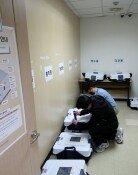[Focus] Bank of Korea¡¯s economic prediction
[Focus] Bank of Korea¡¯s economic prediction
Posted December. 10, 2000 22:52,
Although the Korean gross domestic product (GDP) growth rate is expected to fall to 5.3%, as it is not below the latent growth rate of 5 ~ 6%, there is a less cause for worry, according to the Bank of Korea (BOK). In other words, there should not be worry yet for an economic crash-landing or recession.
However, many are questioning whether such prediction was sound. Soon after the 1997 economic crisis, the BOK was undecided on whether to predict the economic growth rate for 1997 and 1998 at 2.5% or 3.0%. The actual growth rate for 1998 was minus 6.8%. At the end of 1998, the BOK predicted that the growth rate in 1999 would be barely above zero. The actual growth rate for 1999 was a whopping 10.7%. Since the economic crisis in 1997, the predictions have been greatly off.
Some have suggested that any prediction for next year may be useless as there are too many uncertain factors both domestically and internationally. Among various economic research centers, there is a wide discrepancy in the economic growth rate for next year, from 3.9% (UBS Warburg) to 6.8% (LG Economic Research Institute).
Economic engine slowing too quickly, first quarter next year to be the worst:
Starting with the GDP growth rate at 10.7% in 1997, the first quarter in 2000 recorded 12.7% which then fell sharply in the current last quarter to 6.5%. The BOK predicts the first quarter of next year's growth t 5.0%.
The current account balance could also be in the red in the first quarter of next year. BOK predicted the account surplus at $500 million and could record a deficit in the first quarter next year. The account balance going into red would be the first since the third quarter of 1997.
The unemployed for the first half next year is expected to reach 4.5% to 5.0%, a possibility of over 1 million workers without jobs. The consumer price index above 4% has become an undisputed truth. Such numbers are well off the track of the consumer price index increase goal of 2.5% by the BOK.
The BOK predicted that with the second phase of the business and bank restructuring coming to successful end in the second half of next year, alleviating some uncertainty, as well as the stabilization of the U.S. economy could bring the growth rate to 5.4%, the account balance to $4 billion surplus, and the drop in the inflation to 3%.
Varying economic forecasts:
In the coming year, the uncertainty in the international economic situation as well as the uncertainty concerning the second phase business and banking restructuring effectively negates any economic forecast. Reflecting such uncertainty, 17 economic research centers have made predictions widely ranging in numbers. For the next years GDP growth, the numbers range widely from 3.9% to 6.8%. The predicted surplus balance account also varied widely from $1.3 billion to $17 billion.
Hong Chan-Sun hcs@donga.com







